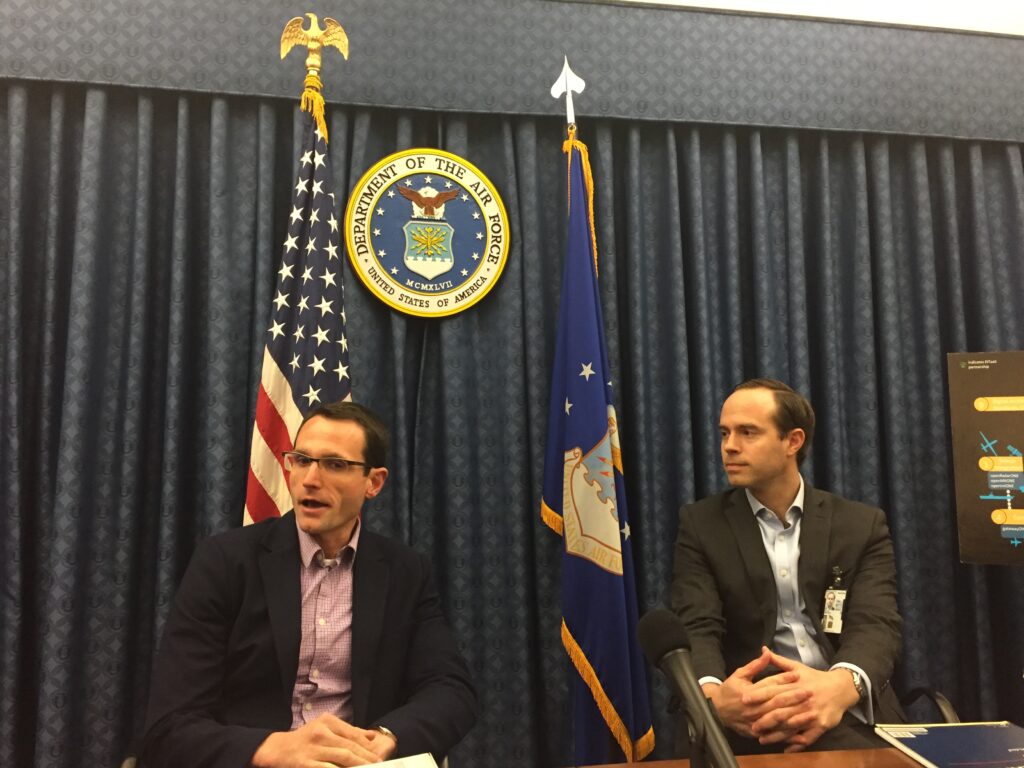
Will Roper (left) and Preston Dunlap
WASHINGTON: The next demonstration of the Air Force’s top-priority Advanced Battle Management System (ABMS) will be much larger in scale and scope than its predecessor, involving 33 different platforms, 70 industry teams and 65 government teams, says Air Force acquisition czar Will Roper.
Roper also told a YouTube “Ask Me Anything” session today that the demo will include experiments with 5G mobile networking for the first time.
“So, 5G is going to be one of the cool things that we bring to the battlefield in the next OnRamp. 5G is going to be evolving — China’s pushing standards, (but) US industry wants to push back with things that we believe are going to be more secure,” he said.
The “On Ramp” demonstration, being held from Aug. 31 to Sept. 5, is the second iteration in the Air Force’s effort to develop a family of systems — as Roper says a “military Internet of Things” — to allow machine-speed command and control (C2) of future all-domain operations.
As Breaking D readers know, it will feature a simulated attack on US space assets and involve three combatant commands: SPACECOM, NORTHCOM, and STRATCOM. A third ABMS onramp later in September will support Indo-PACOM and SPACECOM, “connecting sensors and shooters in a geographic operational theater outside the U.S. for the first time,” according to a July 1 Air Force announcement. And a fourth ABMS exercise in Europe is being designed to include NATO allies.
Roper said that this next demonstration will hopefully also push the envelope in capabilities using machine learning and artificial intelligence (AI) features. For example, he said, DoD’s Project Maven will be playing a part in the ABMS demo, as well as the Joint Artificial Intelligence Center (JAIC).
Project Maven, begun in 2017, was designed to put machine-learning to work to sort through the masses of intelligence, surveillance and reconnaissance (ISR) data generated by DoD and Intelligence Community (IC) platforms. It has been a bit controversial, with Google pulling out of the effort in 2018; and the head of Air Combat Command head Gen. Mike Holmes saying he didn’t believe it was ready for prime time. Roper in June told reporters that he is seeking to take over Project Maven to bring it to “operational reality;” in a press briefing on Aug. 7 he said that Air Force was working to fold Maven would be into ABMS.
“ABMS is about taking the concept of the OODA Loop and transcending it from something that people do to something that machines do,” Roper said in the session moderated by Air Force Chief Architect Preston Dunlap, the de facto program manager for ABMS.
(The OODA Loop, for Observe, Orient, Decide and Act, is the theory of decision making developed by Air Force military strategist John Boyd that is today a fundamental of US warfighting.)
He encouraged industry in the field of data analytics to come forward with new ideas that would enable commanders using future Joint All-Domain Command and Control (JADC2) for connecting military sensors and shooters across the air, land, sea, space and cyberspace domains to direct combat operations at machine speeds.
Roper said one of biggest challenges to ABMS development is the need for DoD to overhaul its traditional approach to information technology, opening up to the greater connectivity that characterizes the civilian world but that the Pentagon has been leery of for security reasons.
“The thing that’s gonna suck — and I really I don’t like to use that word — is that we’ve got to be good at IT. And we’re not. My email does not work the way I would like it to,” he said with evident frustration.
Another challenge, he said, will be breaking DoD out of its traditional mindset regarding acquisition, such as requiring a program to develop a five-year baseline for technology development. ABMS just can’t do that with certainty, because of the way it’s using four-month spirals to iterate new capabilities, Roper said.
“I think we can give them something that is its equivalent, but it’s not going to be written in stone. And I think, ultimately, are we okay writing things in pencil in this building, or do we want that tablet of stone? If the answer is that table of stone, then we’re going to continue communicating the way the Flintstones did,” he said.
Roper said the next step after this second demo would be another open invitation to industry to bring new ABMS ideas to the Air Force.
“What I would ask you to do once we clear this On Ramp is, we’ll do open calls for industry to be able to make solutions, whether you are a traditional defense type company with a big shiny platform that you want to fly or sail or roll along at one of our events and show us how awesome it is … if you’re a company that’s never worked with defense and you’ve got amazing whatever kind of capabilities — phaser guns, proton torpedoes or, you know, the equivalent of the Hal 9000 but one that doesn’t go crazy — we want to hear from you as well,” he said.
Senate passes $95 billion foreign aid bill, as DoD eyes next Ukraine weapons package
Additional aid for Ukraine could be made available “within days” said Pentagon Press Secretary Maj. Gen. Pat Ryder earlier today.

























